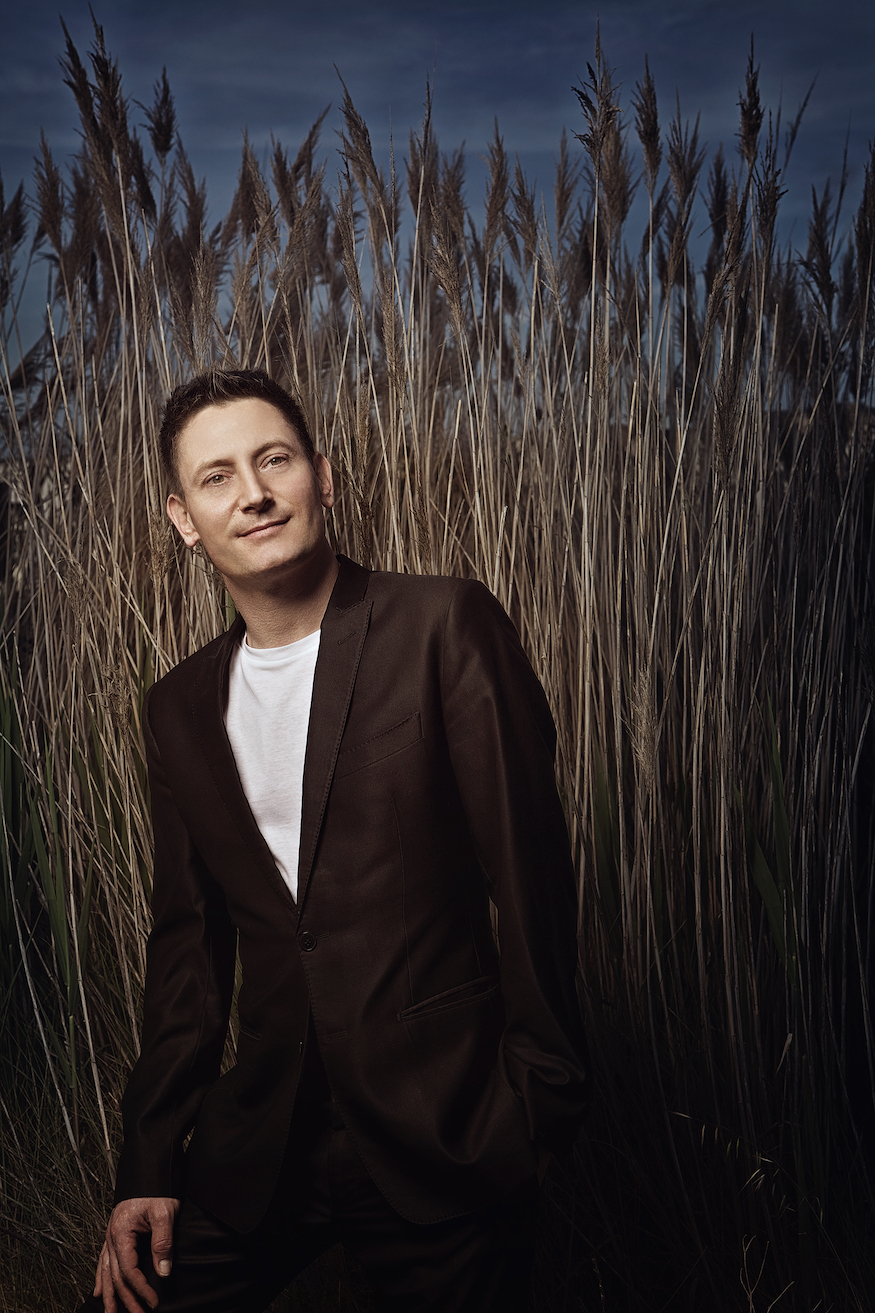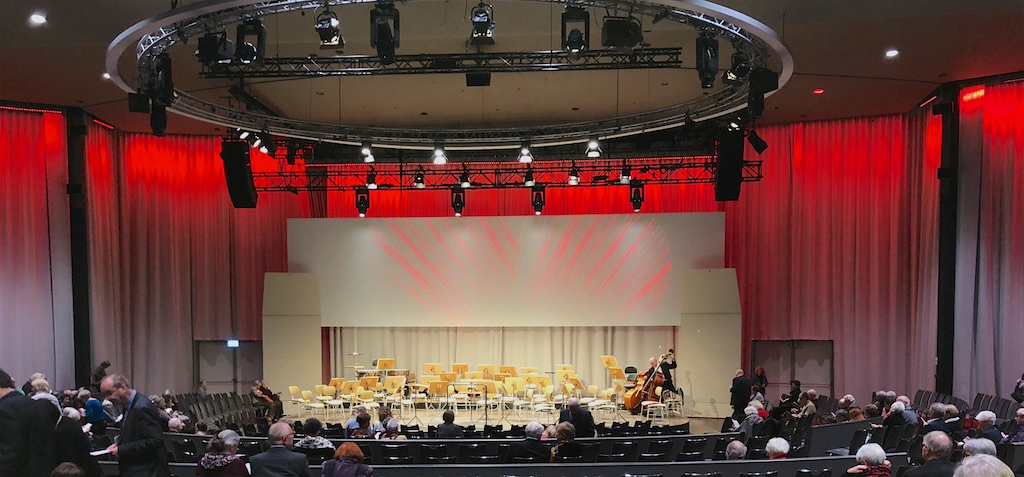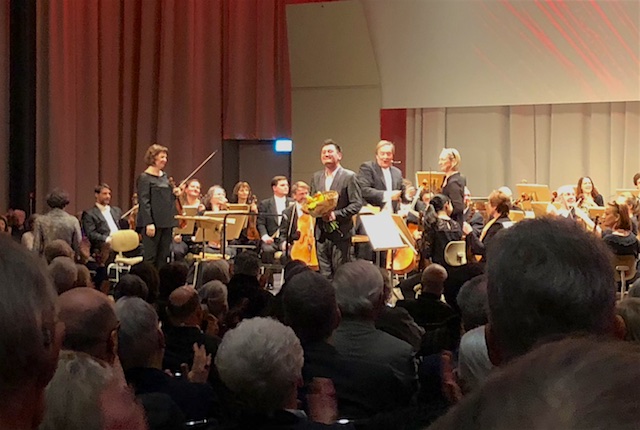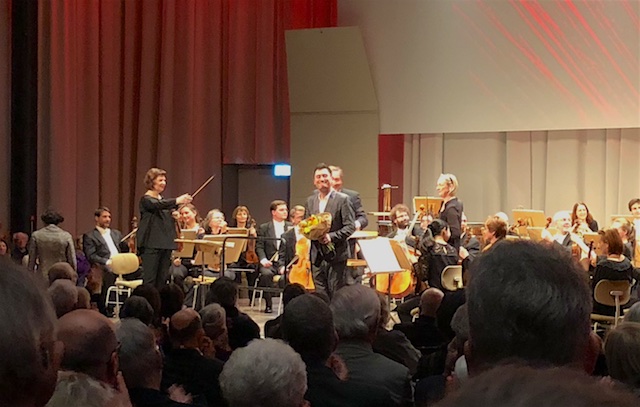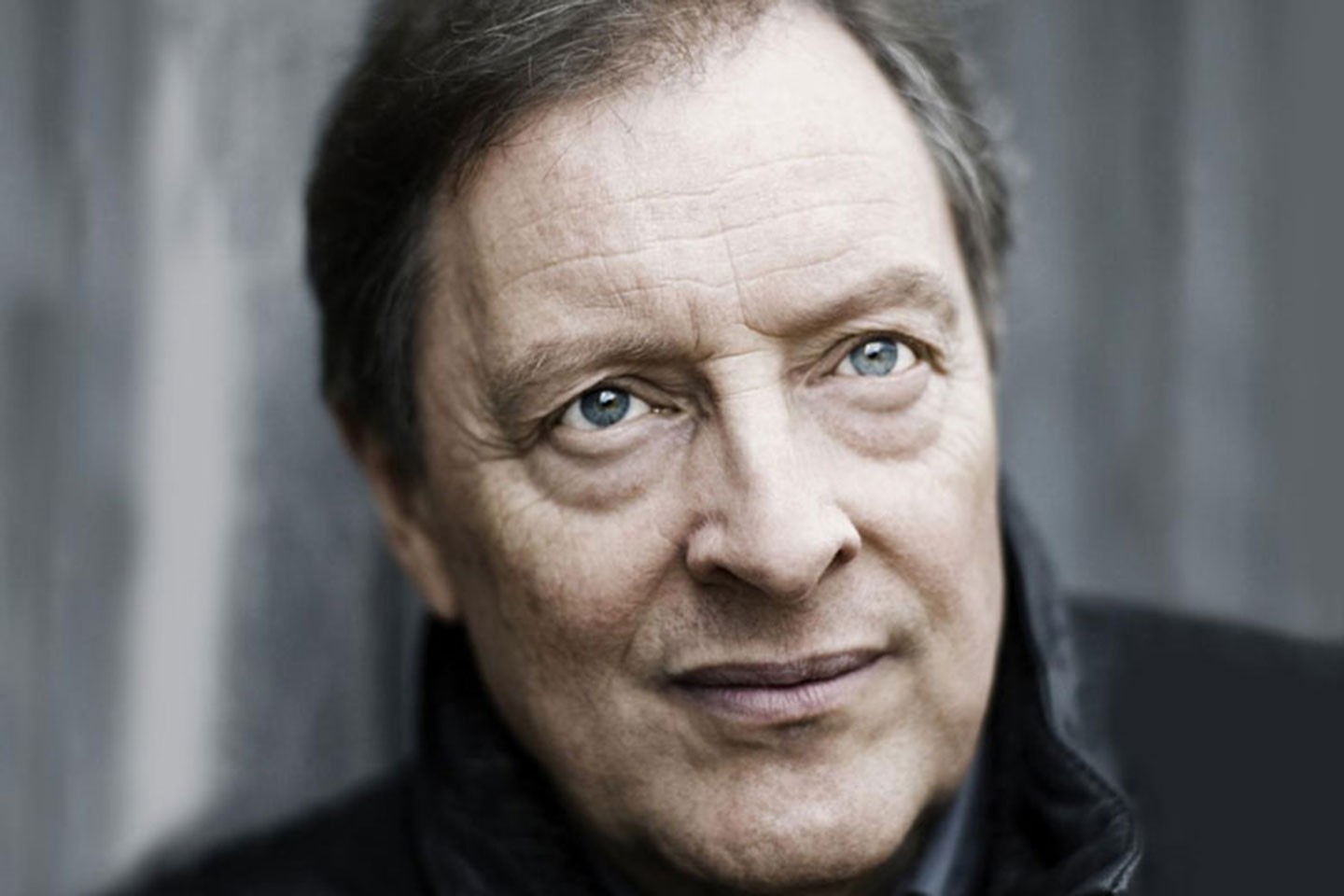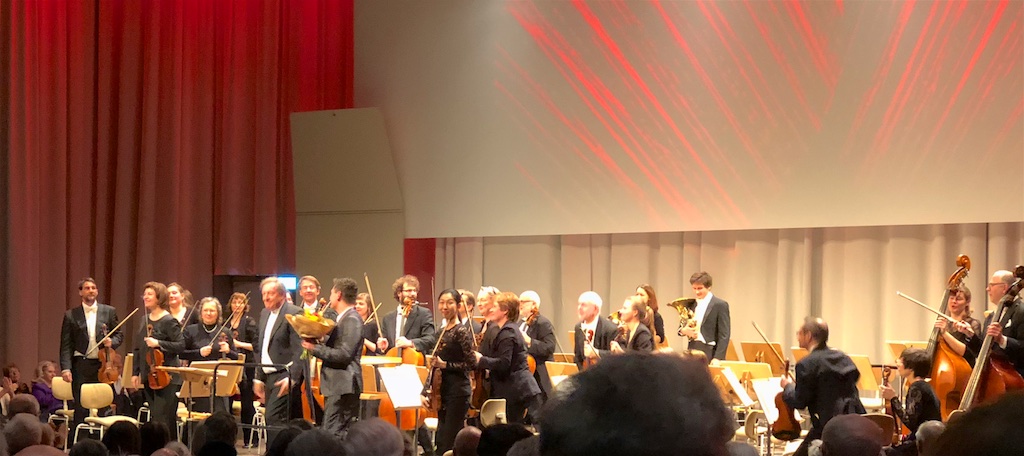Maurice Steger, Howard Griffiths — Brandenburg State Orchestra Frankfurt
Heberle / Mozart / Beethoven
Kursaal Bern, 2018-03-18

2018-03-24 — Original posting
Table of Contents
- Introduction
- Mozart: Concerto for Bassoon and Orchestra in B♭ major, K.191 (186e)
- Heberle: Concerto for Recorder and Orchestra in G major
- Encore — van Eyck: “Engels Nachtegaeltje” from “Der Fluyten Lust-Hof”
- Beethoven: Symphony No.4 in B♭ major, op.60
- Encore — Rameau: “Les Sauvages” from the Opera-Ballet “Les Indes Galantes”
Introduction
Howard Griffiths (*1950, see also Wikipedia) grew up in England and received his musical education at the Royal College of Music in London. Since 1981 he is living in Switzerland. He still is known here primarily as Artistic Director of the Zurich Chamber Orchestra (ZKO), a position he took over in 1996 from its founder, Edmond de Stoutz (1920 – 1997). He kept that position until 2006. In 1997, after this successful engagement in Zurich, he assumed the position of General Music Director of the Brandenburgisches Staatsorchester Frankfurt (Brandenburg State Orchestra in Frankfurt / Oder, right at the border to Poland, see also Wikipedia).
Orchestra
The Brandenburgisches Staatsorchester Frankfurt has its origins in 1842. Of course, there were disruptions, due to all the political events over the past 175 years. Over all that time, the orchestra ran under a variety of names. The last name change was in 1995, when the Brandenburg government declared the Philharmonisches Orchester Frankfurt (Oder) the State Orchestra for Brandenburg. Since then it runs under the current name. Howard Griffiths’ contract runs out in 2018, this concert was part of his international farewell tour with the orchestra.
Besides his work with the two orchestras mentioned above, Howard Griffiths is of course pursuing a wide range of music-related activities, with a particular focus on music-related events for youth, families and children. Besides being guest conductor with numerous international orchestras, one of his key functions is that of artistic director of the Orpheum Foundation for the Advancement of Young Soloists in Zurich.
The Soloist
Maurice Steger (*1971, see also Wikipedia), barely needs to be introduced: he is very well-known as one of the world’s top artists on the recorder. I have previously written about him, in a report about a concert in Zurich on 2014-10-28, where he played a set of highly virtuosic concerti by Vivaldi. In addition to that, I have reviewed several of his recordings, all in the genre of baroque music.
Steger is not the first (and not the last) recorder artist who has extensively covered the baroque repertoire and is looking for “new opportunities”. The recorder disappeared from the concert scene in the late 18th century, but has gained new popularity in the second half of the 20th century, with the revival of period instrument performances: at that time, also composers started creating contemporary works for this instrument family.
Maurice Steger’s repertoire in contemporary music is not very big. It clearly is not the core of what he does. However, like other artists, too, he is also looking at expanding his repertoire by playing adaptations of concertos for other instruments, such as the Mozart bassoon concerto below. The rather peculiar, last (maybe only) classical concerto for recorder by Anton Heberle, also featured in this concert, is another one of these “repertoire extensions”.
Maurice Steger and Howard Griffiths know each other well. They have performed together in numerous concerts, especially back in the years when Howard Griffiths was Artistic Director of the ZKO.
The Venue
The venue for this concert was the Kursaal in Bern. That’s not really a proper venue for classical concerts. However, it’s one of the halls that serve as replacement for the main concert venue in Bern: the Kultur Casino is currently undergoing renovation. The Kursaal venue has the form of a flat arena, with the audience forming a semi-circle around the central, round podium. There is also a balcony around most of the audience. Allegedly, the hall has received measures for acoustic enhancement. In my experience now, the acoustics are fairly dry, still.
Mozart: Concerto for Bassoon and Orchestra in B♭ major, K.191 (186e)
Wolfgang Amadeus Mozart (1756 – 1791) composed his Concerto for Bassoon and Orchestra in B♭ major, K.191, in 1774, aged 18. This is the single, most popular piece in the entire literature for the bassoon. The score asks for an orchestra with 2 oboes, 2 horns, and strings. The concerto features three movements:
- Allegro (4/4)
- Andante ma Adagio (2/2)
- Rondo: Tempo di Menuetto (3/4)
Maurice Steger played an adaptation of this concerto for alto recorder. This implies that the solo part sounded two octaves higher (mostly) than the original for Bassoon.
The Performance
I. Allegro
The beginning of the concerto stands for so much that we know and like in Mozart’s music: serenity, clarity, joy, esprit. It’s music that seemed to suite the orchestra very well. Howard Griffith obviously trained the orchestra to play actively, with light, springy articulation, the jumping semiquaver figures in light and clear staccato. I also found the dynamics very careful and differentiated, with clear accents. The tempo was fresh, fast enough to feel light, but not pushed, such that the articulation was still clear also in the appoggiaturas.
Mozart has carefully laid out the texture of the score, such that the bassoon solo gets plenty of presence within the ensemble. I was pleased to realize that from the point-of-view of acoustic balance the alto recorder effortlessly could establish and maintain its position: it probably has less volume, but the extra octave at least compensates for this. In terms of tone and articulation, the solo sounded close to baroque (certainly not overly romantic).
Solo, Cadenza
I wasn’t too happy with the general concept of adapting for the recorder (see below), but it was most obvious that the soloist enjoyed this excursion into unusual repertoire. Maurice Steger could not resist some fun, if not a little joke with the first, short cadenza at bar 97. He also added some extra ornaments and fioriture in the second half of the concerto.
The big/main cadenza, finally, was—typical Steger, and a typical recorder version (one can hardly deny this opportunity!). I found the cadenza very effective (needless to say: with excellent, masterful recorder playing), relying on / strongly tied to material from the movement. Yet, it was full of fantasy and surprises. The one downside: the open acoustics of the venue offered very little support for the recorder. So, soft segments didn’t have the “full effect” in the listener’s ear.
II. Andante ma Adagio
I think that the extra air consumption with the recorder caused this movement to lose some of its calm character. The instrument appeared to make it harder to play and enjoy the long cantilenas. Maurice Steger’s cadenza was certainly a “recorder version”. However, it seemed a bit “off-topic”. As a listener, I felt that I’m losing track of where he wanted to go. On the part of the orchestra, I think that especially the cellos and double bass should have better taken into account the softer character of the solo instrument. The pizzicato sequences sounded rather uniform, if not a bit coarse. To me, they were not subtle enough, maybe lacking some agogic play?
III. Rondo: Tempo di Menuetto
To me, the short, last movement clearly was the one most suited for the recorder. And it was the one in which Maurice Steger seemed to feel most at ease, “at home”. One could tell this from is lively body language, the joy with which he added little variants to the bassoon part. It sure must have been fun for him to play this!
Suited for Recorder?
Maurice Steger has my full understanding for trying Mozart’s concerto on the recorder. However, that composer was a master at exploiting the specifics, the characteristics of any solo instrument. And so, any “translation” for the recorder will be facing problems / deficiencies:
- one of the key characteristics of the bassoon is in its “percussive” articulation, which lets every tone start (and end) “abruptly” (you can’t “sneak into a tone”). In rapid figures and ornaments, especially trills and turns, this characteristic is most obvious and leads to very clear, pronounced articulation even with the shortest notes. The articulation on a recorder is inherently softer, certainly different (despite the use of the tongue), which automatically shifts the focus from the fast notes to the long ones.
- as any double-reed instrument, the air/breath consumption on the bassoon is very low, allowing for very long phrases. The recorder with its open wind channel requires more air. Sso, in comparison to the bassoon, the recorder has a tendency to sound short-breathed.
The recorder has potential advantages, in that it offers for more colors, more variability in articulation, probably also for a wider dynamic range. One could even see the (possibility for) soft articulation as an advantage—in general. However, with Mozart’s writing specifically for the bassoon, these “advantages” are of very little help here.
Overall, I would regard the adaptation of Mozart’s bassoon concerto for alto recorder a partial success only. Though, of course, it still was a joy to listen to. Or, as Howard Griffiths stated “The bassoon isn’t too happy about this, but we had fun with this”.
Heberle: Concerto for Recorder and Orchestra in G major
We don’t know much about Anton Heberle (c.1780 – c.1816), not even when exactly he died, or when and where he was born. He made some well-documented concert appearances in cities such as Vienna, Pest, Ragusa, Trieste, and Venice: a traveling artist on peculiar types of recorders, now even hard to characterize. One exception is the fact that he called himself the inventor of the Csakan, a recorder in the form of—or hidden inside—a walking stick. This instrument enjoyed a brief period of popularity in the early 19th century, but then disappeared from the scene. There were very few composers who wrote for this instrument. Most of these compositions are in the genres of solo or chamber music.
Anton Heberle’s Concerto for Recorder, Strings and 2 Horns ad lib. in G major may be the only concerto written for the Csakan. Originally, the composition was in E♭ major. The Danish recorder player Michala Petri (*1958) transposed the concerto to G major, in order to make it playable on the soprano recorder. The concerto features three movements:
- Allegro moderato
- Romance
- Tempo di Menuetto
The Performance
I. Allegro moderato
I have no idea how the Csakan really sounded, but Maurice Steger used a pronouncedly flexible tone on his soprano recorder, also adding extra ornamentation, as he felt appropriate. While on older recordings, the tone of a soprano recorder often can be rather “stingy” and straight, here, it was—apart from some high peak notes—quite the contrary. Actually, Steger’s playing was so differentiated that it made the solo violin (concert master) sound rather coarse at times.
II. Romance
The thematic material in this movement is somewhat poor. It’s a set of variations on a rather simple theme. Luckily, Maurice Steger mobilized all of his fantasy, in order to turn this into an entertaining, playful intermezzo, such that the listener forgot the trivial, recurring harmonic structure of the theme.
III. Tempo di Menuetto
What an excellent idea: rather than playing this in “pleasant” Tempo di Menuetto, Steger and Griffiths turned this into furious, very virtuosic finale, taking it at the fastest possible pace (such that clear articulation was just still possible): a fun piece! In the original, the contrasting Trio reminds me of a rather heavy, if not clumsy Bavarian Schuhplattler dance. Steger successfully avoided this impression by turning this into a joyful, light-hearted little miniature. The return of the Menuetto was even faster, more virtuosic. It featured a fancily joking “miniature cadenza”. Congratulations also to the orchestra for keeping up with Steger’s challenging pace!
Heberle’s original composition is a nice, but somewhat harmless concerto. Some passages even sound rather trivial. The solo part has rather virtuosic passages, but the musical (melodic, harmonic) substance can at best be described as “pleasant”, maybe “interesting”. It definitely is not music that one would want to hear over and over again. However, Steger’s realization goes beyond that: thanks to his differentiated, ornamented playing, his broad scope in expression, articulation and virtuosic means make this concerto a really enjoyable, even fun experience!
Encore — van Eyck: “Engels Nachtegaeltje” from “Der Fluyten Lust-Hof”
Maurice Steger’s vivid and virtuosic performance in the two concerti led to a long applause, so the artist offered a little gem in his repertoire as an encore. It’s one of the highlights of the entire recorder literature: the famous fantasy “Engels Nachtegaeltje” from “Der Fluyten Lust-Hof” (the “English Nightingale” from the collection “The flute’s garden of desire”) by the Dutch composer Jacob van Eyck (1590 – 1657).
With this, Maurice Steger returned to the core of his repertoire, the early baroque: a time when the recorder was really popular. He called van Eyck’s fantasy a “partial / composed improvisation. And improvise he did, indeed—and how! He used all of his fantasy and virtuosic art to turn this in to an overwhelmingly rich kaleidoscope, a tiny masterpiece. It was far beyond the imitation of bird song. To me, at least, it was one of the true highlights of the evening!
Beethoven: Symphony No.4 in B♭ major, op.60
Ludwig van Beethoven (1770 – 1827) wrote his Symphony No.4 in B♭ major, op.60 in 1806. I have posted information on this composition in a detailed comparison of several recordings in an earlier note, so here I’m just listing the movements:
- Adagio (2/2, ♩=66) — Allegro vivace (2/2, 1/1=80)
- Adagio (3/4, ♪=84)
- Menuetto: Allegro vivace (3/4, 3/4=100) — Trio: Un poco meno Allegro (3/4=88)
- Allegro ma non troppo (2/4, 1/2=80)
The Performance
With Beethoven’s symphony, the attention now focused on the orchestra and its conductor. As far as the acoustics are concerned: the sound was clear, rather dry (lacking reverberation), which isn’t necessarily a bad thing. I did find, though, that cellos and basses deserved a bit better acoustic support.
I. Adagio — Allegro vivace
The movement starts with a slow introduction of 38 bars. It is building up tension and expectation. At the same time, the music gradually moving from pp to ff—very theatrical, indeed! Howard Griffiths took the Allegro vivace part with its spectacular beginning at a fast, fluent pace, probably at the limit for still maintaining coordination in the orchestra (the acoustic environment may have been challenging for the musicians, though). I found the orchestra’s playing to be alert, having momentum and forward-orientation. It may have been a bit solid at times, but still, in this venue, the sf accents had only limited effect. Certainly, Howard Griffiths and his musicians let the motoric components in the score drive the music.
II. Adagio
As noted in earlier posts on this composition, this is one of the most challenging movements in the entire symphonic literature. The difficulties are not just in the rhythmic accuracy, coordination, etc., but also in maintaining tension across the piece. And: maintaining the calm characteristics of an Adagio, while at the same time not letting the pace run away.
In Griffiths’ interpretation, the movement started in good Adagio mood. It exhibited very nice cantilenas in the woodwinds, and diligent, careful dynamics in the pp. The performance maintained tension, and the conductor resisted any tendency to “sit down” in lyrical parts. The tempo remained stable, even though there were slight signs of unrest later in the movement.. This just proves how difficult it is to maintain the Adagio characteristics! The last 16 bars (but also earlier parts of the movement) feature rolling demisemiquaver motifs that are passed on between the string voices. Here, the “handshake” between the voices wasn’t always as seamless as it could be. It felt as if the instrumentalists wanted to “play safe”, in rather having a little gap than for the motifs to collide.
III. Menuetto: Allegro vivace — Trio: Un poco meno Allegro
A Menuetto that really is a Scherzo: it actually feels as if all of a sudden the horses are let loose! Howard Griffiths chose a rather fresh, forward-moving tempo, also in the Trio part. I liked the vivid dynamics, the alert playing, even though occasionally, my preference would have been to allow for a little more agogic play. I particularly enjoyed the woodwinds, while again the playing in the string voices was a bit on the solid side. And I found that the horns sounded somewhat dim. I’m not sure how much of this one can attribute to the acoustics. Maybe I expected natural horns?
IV. Allegro ma non troppo
The Finale is a true, virtuosic orchestral showpiece. Howard Griffiths didn’t spare his musicians from the challenges of a “sporty” tempo (which the score asks for!). The playing was virtuosic, relentless: a bravura piece that didn’t allow the listener to lean back in indulgence. Griffiths avoided theatrical exaggerations or pathos. At the same time, the tempo remained controlled, did not feel rushed. The orchestra sound was transparent, thanks to the light articulation. However, the string voices were definitely operating at their (speed) limit. Also the bassoon barely had time for its utterly challenging, fast semiquaver passages. But overall, it did an admirable job at these.
Congratulations to the orchestra for a refreshing, lively presentation of this often underestimated, challenging symphony!
Encore — Rameau: “Les Sauvages” from the Opera-Ballet “Les Indes Galantes”
Beethoven’s Finale literally provokes strong applause. Howard Griffiths indeed announced an encore—one, for which Maurice Steger re-joined the orchestra! Also in this second encore, we found ourselves back in the baroque era: “Les Sauvages” from the Opera-Ballet “Les Indes Galantes”, by Jean-Philippe Rameau (1683 – 1764). For an encore, I didn’t mind if the refrain sounded a bit solid: the lyrical middle part felt more baroque than the rest. However, with a duration of just over a minute, it fulfilled its mission as a “last dance”. Thanks for a pleasant, entertaining evening!


